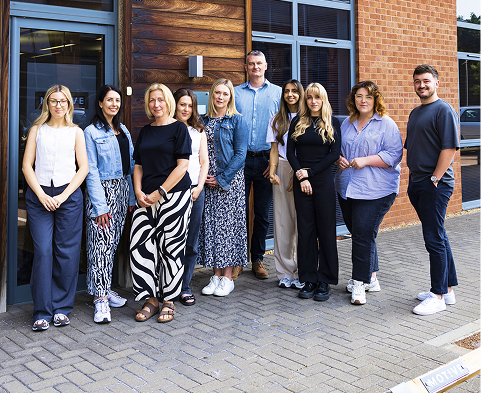If you’ve ever typed a quick “what’s the best...?” question into ChatGPT or Gemini, or even relied on Alexa or Siri for an answer, then you’ve already been interacting with a Large Language Model, or LLM. These models have changed how people search for information, find recommendations, make decisions, and even form impressions of brands.
.jpg)
For years, the ultimate benchmark for visibility was landing on the first page of Google. Companies would grow around Search Engine Optimisation (SEO) and find ways to climb those rankings. But now, people aren’t scrolling through search results to find answers to their questions. Instead, they’re being served instant, AI-generated summaries that pull together insights from across the web, often without ever clicking through to the original sources. Data reveals that one of the most popular LLMs, ChatGPT, has 700 million weekly active users as of August 2025, up from 300 million in December 2024 – showing that the reliance on AI tools is growing at a rapid rate.
To make sure your brand still thrives in search results, you need to think beyond keywords, backlinks and rankings, and start focusing on metrics that boost visibility in AI-generated answers. LLMs are trained on a huge amount of text data, such as books, articles, studies and websites. The important thing here is that they prioritise information from sources they see as authoritative and credible, and that’s where PR steps in. Strategic media placements in high-quality publications give your brand the third-party validation you need to signal to LLMs that your brand is worth referencing when generating answers.
In this blog post, we’ll break down what LLMs actually are, why they matter so much for PR, and how you can make sure your brand is showing up in the sources that feed LLMs.
What’s in this article:
- What are LLMs?
- Why do LLMs matter in digital PR?
- How do you boost your visibility in LLM search results?
- Key takeaways
What are LLMs?
LLMs have become a real buzzword in the digital marketing world, but let’s break it down in plain terms. LLM stands for Large Language Model, which is essentially a type of artificial intelligence trained to understand and generate human-like text. They perform natural language processing tasks, such as answering questions, summarising information, translating languages and generating creative content. LLMs are easily accessible to the public through AI assistants such as OpenAI’s ChatGPT, Microsoft’s Copilot, Google’s Gemini and Meta’s Llama models.
When you ask one of these models a question, the model isn’t pulling an answer from one single place. It’s identifying patterns it has learned from enormous amounts of data, like articles, books, research papers, websites, and more. Instead of simply matching keywords the way traditional search engines do, an LLM captures deeper context to predict the most relevant and natural-sounding response to your query.
However, it’s important to note that LLMs don’t “think” in the way people do. They’re not forming original opinions or making assumptions, but instead they combine information from countless sources to generate answers. For example, if you type in “What is the best moisturiser for sensitive skin?”, LLMs would rely on the information that’s already out there, and recommend products based on sources such as customer reviews, product round-up articles and expert opinions.
Why do LLMs matter in digital PR?
Digital PR isn’t all about rankings and backlinks anymore. With the rise of Large Language Models, it’s now a key strategy to make sure your brand is recommended, not just found. Unlike traditional search engines, LLMs rarely give users a list of links to click on. Instead, they generate answers directly in the interface, a concept often called “zero-click search.” That means users get the information they need without ever visiting your website, so if your brand isn’t mentioned in that output, it might not be seen at all. With research showing that 69% of people in the UK use AI for work, study, or personal reasons, if your brand doesn’t appear in these AI-generated results, you risk being invisible to a large and growing audience.
Search engines are catching up too. Take Google’s AI Overview, for example, which puts AI-generated summaries right at the top, pulling together info from different sources to answer questions. That means even those who are still using traditional search engines might never scroll past that AI snippet. Being absent from the sources these models trust could mean your brand gets completely overlooked.
Digital PR now has two layers to think about. On one side, you still want traditional media coverage that helps with SEO and backlinks. But on the other hand, you need mentions and features that feed directly into the kinds of sources LLMs pull from. The key here is quality over quantity – it’s about getting the right mentions in trusted publications. That’s what gets your brand cited when AI is answering questions like “What’s the best product for X?” or “Which company offers Y service?”.
Basically, PR becomes the bridge between your brand and those AI recommendations. Even if people aren’t clicking through to your site, being included in AI-generated answers builds credibility and influence. The more your brand is talked about in the right places, the more likely it is that AI will recommend your brand and describe your products or services accurately.
How do you boost your visibility in LLM search results?
So now that we know why brands need to be visible in AI-generated search results, the next question is: how do you actually make it happen? It’s not enough to focus purely on traditional SEO tactics like heavy link-building and driving traffic to your website. Now, it’s about getting your brand mentioned consistently in the right places, building authority, and earning third-party validation. In many ways, it’s a return to the fundamentals of traditional PR, but with a modern twist. Now those mentions don’t just reach people, but they also feed directly into LLMs, increasing the likelihood of your brand getting mentioned in the AI-generated answers.
A report from Ahrefs revealed branded web mentions have the strongest correlation with visibility in AI-generated answers, far outperforming traditional backlinks. Brands with the most mentions can appear in up to ten times more Google’s AI Overviews than those in the next closest tier.
.jpg)
The report also showed that off-site presence matters more than ever, as the top three correlations, including brand web mentions, brand anchors, and brand search volume, are all off-site factors. This means generative search visibility isn’t just about what’s on your website. It’s about how your brand shows up across the web, and earning relevant media placements through PR is what puts your brand in those credible sources in the first place. Through PR, you can secure brand mentions in product round-ups, thought leadership pieces, reviews and general industry-specific articles which all create a pattern of validation, showing LLMs that your brand is genuine and credible.
The good news is, a lot of the things that work for LLM visibility are the same things PR pros have always been great at, which is getting your brand talked about in the right places, by the right people.
Here are a few tips to try and boost your chances of showing up in AI-generated answers:
Get featured in authoritative publications
AI tools like ChatGPT and Google's AI Overview pull information from credible sources to generate answers. By securing placements in high-authority publications, you increase the chances of your brand being included in AI-generated answers.
Embrace brand mentions, not just backlinks
While backlinks are important for SEO, they're not the primary factor for AI visibility. Ahrefs' study found that branded web mentions have a stronger correlation with AI Overview brand visibility than the number of backlinks and domains, or domain rating. So, aim to get your brand mentioned in reputable sources, even if they don't link back to your site.
Secure product round-ups and reviews
Being featured in product round-ups and reviews can significantly boost your AI visibility. These types of content are often cited by AI tools when generating answers to common “best of” or “which one should I choose?” style questions. To increase your chances of being included, reach out to journalists and bloggers in your industry, personalise your pitches, and provide product samples when appropriate.
Quality over quantity
It’s not about securing as many mentions as possible - what matters is where and how you’re mentioned. Being part of conversations relevant to your industry and brand carries far more weight than scattershot coverage.
Maintain consistent messaging
LLMs look for patterns and consistency when deciding what sources to trust. If your brand sounds one way on your website but completely different in media coverage or social channels, it can weaken credibility. Keeping your messaging aligned across all platforms reinforces authority.
Monitor your AI visibility
Tools like Ahrefs' Brand Radar allow you to track how often your brand is mentioned in AI Overviews. Monitoring your AI visibility can help you understand which strategies are working and where you need to improve.
.jpg)
Key takeaways
- What LLMs are: Large Language Models (LLMs) are AI tools trained to understand and generate human-like text. They’re changing how people search online, providing instant answers instead of scrolling through pages of results.
- Visibility matters: If your brand isn’t part of AI-generated search results, you risk being invisible to audiences using tools like ChatGPT, which has 700 million weekly active users as of August 2025. In the UK, 69% of people use AI for work, study, or personal reasons.
- Authority counts: LLMs prioritise information from credible, trustworthy sources. Securing placements in high-authority publications signals to AI that your brand is reliable.
- Mentions > backlinks: For LLM visibility, branded mentions matter more than backlinks. While links still help, being talked about across the web has a stronger impact on appearing in AI Overviews.
- Quality over quantity: Focus on the right tactics – product round-ups, expert commentary, and trusted media – rather than chasing as many mentions as possible.
If you’re interested in prioritising LLMs and AI visibility in your PR and marketing strategy, get in touch to discuss how we can support you.



.jpg)

.jpg)
.jpg)


.jpg)

